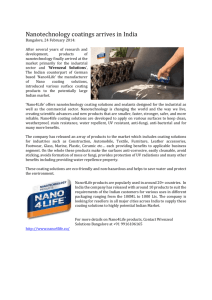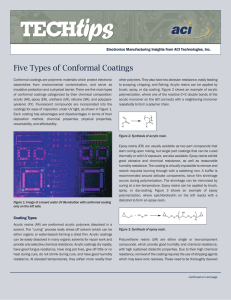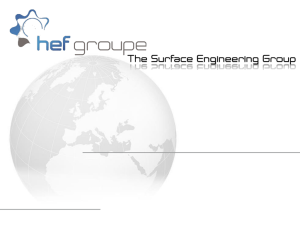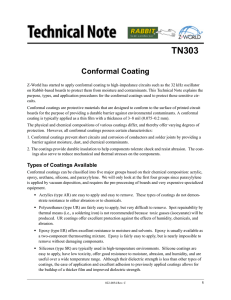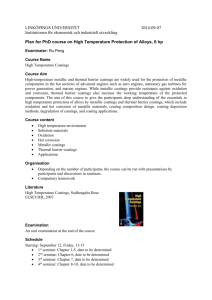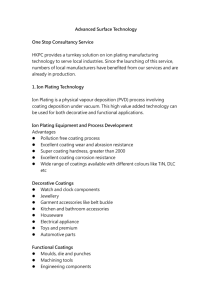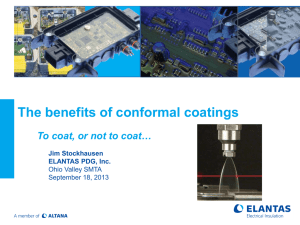Conformal Coating Standards - Protection in Harsh
advertisement
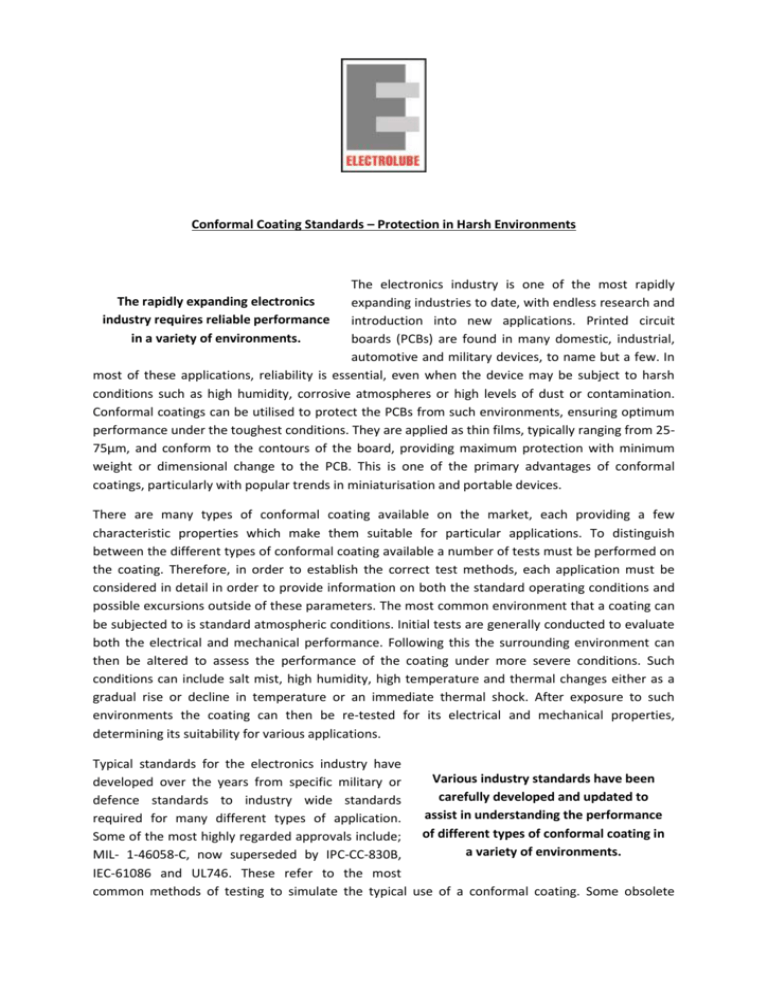
Conformal Coating Standards – Protection in Harsh Environments The electronics industry is one of the most rapidly expanding industries to date, with endless research and introduction into new applications. Printed circuit boards (PCBs) are found in many domestic, industrial, automotive and military devices, to name but a few. In most of these applications, reliability is essential, even when the device may be subject to harsh conditions such as high humidity, corrosive atmospheres or high levels of dust or contamination. Conformal coatings can be utilised to protect the PCBs from such environments, ensuring optimum performance under the toughest conditions. They are applied as thin films, typically ranging from 2575µm, and conform to the contours of the board, providing maximum protection with minimum weight or dimensional change to the PCB. This is one of the primary advantages of conformal coatings, particularly with popular trends in miniaturisation and portable devices. The rapidly expanding electronics industry requires reliable performance in a variety of environments. There are many types of conformal coating available on the market, each providing a few characteristic properties which make them suitable for particular applications. To distinguish between the different types of conformal coating available a number of tests must be performed on the coating. Therefore, in order to establish the correct test methods, each application must be considered in detail in order to provide information on both the standard operating conditions and possible excursions outside of these parameters. The most common environment that a coating can be subjected to is standard atmospheric conditions. Initial tests are generally conducted to evaluate both the electrical and mechanical performance. Following this the surrounding environment can then be altered to assess the performance of the coating under more severe conditions. Such conditions can include salt mist, high humidity, high temperature and thermal changes either as a gradual rise or decline in temperature or an immediate thermal shock. After exposure to such environments the coating can then be re-tested for its electrical and mechanical properties, determining its suitability for various applications. Typical standards for the electronics industry have Various industry standards have been developed over the years from specific military or carefully developed and updated to defence standards to industry wide standards assist in understanding the performance required for many different types of application. Some of the most highly regarded approvals include; of different types of conformal coating in a variety of environments. MIL- 1-46058-C, now superseded by IPC-CC-830B, IEC-61086 and UL746. These refer to the most common methods of testing to simulate the typical use of a conformal coating. Some obsolete standards, such as DEF-STAN 59/47, are also considered important within the industry but newly developed coatings can no longer be approved to these standards. IPC (The Institute for Interconnecting and Packaging Electronic circuits), IEC (International Electrical Commission) and UL (Underwriters Laboratory) are the three main test bodies associated with coatings for (loaded) printed wiring boards. Most approvals consist of many stages and refer to specific methods for each individual test. These methods are also commonly associated with certain governing bodies such as; ASTM (American Society for Testing and Materials), BSI (EN) (British Standards Institute (European)), DIN (German Institute for Standardisation) as well as various IEC methods. These methods carefully describe the set up parameters required to evaluate a coating and can be used as a basis for all conformal coating testing, allowing for a comprehensive comparison of different chemistries and processes to be conducted. Environmental testing often consists of elevated levels of humidity or salt mist and general changes in temperature. A humid or salt atmosphere is created in a corrosion testing chamber, typically at around 85% humidity, 35˚C and for salt mist, 5% salt. The atmosphere is kept constant within the chamber for a set amount of time. This can vary from 24 hours to a number of weeks depending on the requirements. The surface insulation resistance (SIR) is measured before, during and immediately after environmental exposure. In order to meet industry standards for high humidity environments, a voltage of around 50Vdc is applied to the board during the test and the SIR of the coating should not be lower than 108 ohms for the duration of the test. Thermal testing is designed to simulate all possible scenarios, particularly those in extreme conditions such as military, aerospace or automotive applications. Thermal cycling tests are carried out in one chamber where the temperature is changed at a set rate. The highest specification in industry standards is a rate of change of temperature set at 12⁰C/min, covering a temperature range of approximately -55⁰C to +125⁰C. Thermal shock tests are slightly different, however. In this case, the board is transferred between one chamber set at the lowest temperature to another set at the highest temperature, with no dwell time in between. The flexibility, appearance and SIR are all evaluated following a set number of cycles through either the gradual or shock method. Other performance testing of conformal coating includes the evaluation of electrical properties. This is essential to all applications of conformal coatings to a printed circuit board, regardless of the environment it is exposed to. Typical tests, also outlined in many of the standards discussed previously, are dielectric strength, surface resistivity, dissipation factor and dielectric constant. Additionally, further specialist properties may be required such as flame retardance and resistance to moulds and fungi, harsh chemicals, UV light or corrosive gases, for example. Due to fairly recent changes in the manufacture of PCBs, another particularly relevant property is the ability of conformal coatings to inhibit the growth of tin whiskers – a subject which is under much review and testing at the moment. Selection of the most suitable coating for each application is essential to ensure reliability and optimum performance of the device. In summary, to select the best coating it is imperative that the application is considered in detail, highlighting all possible exposure scenarios and considering all processing factors. For standard atmospheric conditions many conformal coatings available on the market will provide the level of protection required. Therefore, the decision in this case would most likely surround the processing conditions and associated hazards of using each material. For harsher environments, the various chemistry and coating types should be evaluated thoroughly. For example, acrylic coatings, such as Electrolube Ltd IPC-CC-830B approved TFA, offer good environmental protection with superior clarity and stability following prolonged exposure to UV light. Acrylic coatings do not crosslink and therefore do not provide the required protection against chemicals or high humidity environments where prolonged condensation or periodic immersion in water is likely. In this case, a tougher coating such as Electrolube Ltd UL746 approved DCA or environmentally friendly Non-VOC Coating (NVOC) would provide superior protection and therefore optimum performance of the device under these conditions. To meet demanding requirements set by the variety of electronic applications now possible, the conformal coatings market continues to expand at an equally rapid pace. Electrolube are at the forefront of this developing industry, providing unparalleled technical support for customers and offering many solutions for a vast array of conditions and processes worldwide. Jade Bridges R&D Manager Electrolube Ltd



